Genoprotective Effect of Some Flavonoids against Genotoxic Damage Induced by X-rays In Vivo: Relationship between Structure and Activity
Abstract
:1. Introduction
2. Materials and Methods
2.1. Chemicals and Reagents
2.2. Micronucleus Assay in Mouse Bone Marrow (Micronuclei in Polychromatic Erythrocytes (MnPCEs))
2.3. Irradiation
2.4. Statistical Analysis
3. Results
3.1. Administration of Test Substances Prior to Exposure to Ionizing Radiation
3.2. Administration of Test Substances after Exposure to Ionizing Radiation
4. Discussion
- Antiradical activity (●OH, hydroxyl.
- Antiradical activity (O2●−, superoxide).
- Metal chelating activity.
- Antilipoperoxidant activity (R●, alkyl; ROO●peroxy; RO●, alkoxy).
- The activation and/or inhibition of various enzymes related to this oxidative metabolism.
5. Conclusions
Supplementary Materials
Author Contributions
Funding
Institutional Review Board Statement
Informed Consent Statement
Data Availability Statement
Conflicts of Interest
References
- Morel, I.; Lescoat, G.; Cogrel, P.; Sergent, O.; Pasdeloup, N.; Brissot, P.; Cillard, P.; Cillard, J. Antioxidant and iron-chelating activities of the flavonoids catechin, quercetin and diosmetin on iron-loaded rat hepatocyte cultures. Biochem. Pharmacol. 1993, 45, 13–19. [Google Scholar] [CrossRef]
- Salah, N.; Miller, N.J.; Paganga, G.; Tijburg, L.; Bolwell, G.P.; Rice-Evans, C. Polyphenolic flavanols as scavengers of aqueous phase radicals and as chain-breaking antioxidants. Arch. Biochem. Biophys. 1995, 322, 339–346. [Google Scholar] [CrossRef] [PubMed]
- Wang, P.F.; Zheng, R.L. Inhibitions of the autoxidation of linoleic acid by flavonoids in micelles. Chem. Phys. Lipids 1992, 63, 37–40. [Google Scholar] [CrossRef]
- Benavente-García, O.; Castillo, J.; Marin, F.R.; Ortuño, A.; Del Río, J.A. Uses and properties of Citrus flavonoids. J. Agric. Food Chem. 1997, 45, 4505–4515. [Google Scholar] [CrossRef]
- Benavente-García, O.; Castillo, J.; Alcaraz, M.; Vicente, V.; Del Río, J.A.; Ortuño, A. Beneficial action of Citrus flavonoids on multiple cancer-related biological pathways. Curr. Cancer Drug Targets 2007, 7, 795–809. [Google Scholar]
- Benavente-García, O.; Castillo, J. Update on uses and properties of Citrus flavonoids: New findings in anticancer, cardiovascular, and anti-inflammatory activity. J. Agric. Food Chem. 2008, 56, 6185–6205. [Google Scholar] [CrossRef]
- Hodek, P.; Trefil, P.; Stiborová, M. Flavonoids-potent and versatile biologically active compounds interacting with cytochromes P450. Chem. Biol. Interact. 2002, 139, 1–21. [Google Scholar] [CrossRef]
- Thompson, W.R.; Meinwald, J.; Aneshansley, D.; Eisner, T. Flavonols: Pigments responsible for ultraviolet absorption in nectar guide of flower. Science 1972, 177, 528–530. [Google Scholar] [CrossRef]
- Bate-Smith, E.C. Phytochemical Ecology; Harborne, J.B., Ed.; Academic Press: London, UK, 1962. [Google Scholar]
- Loschke, D.C.; Hadwiger, L.A.; Wagoner, W. Comparison of mRNA populations coding for phenylalanine ammonia-lyase and others peptides from pea tissue treated with biotic and abiotic phytoalexin inducers. Physiol. Plant Pathol. 1983, 23, 163–173. [Google Scholar] [CrossRef]
- Grab, D.; Loyal, R.; Ebel, J. Elicitor-induced phytoalexin synthesis in soybean cells: Changes in the activity of chalcone synthase mRNA and the total population of translatable mRNA. Arch. Biochem. Biophys. 1985, 243, 523–529. [Google Scholar] [CrossRef]
- Dixon, R.A.; Dey, P.M.; Whithead, I.M. Purification and properties of chalcone isomerse from cell suspension cultures of Phaselus vulgaris. Biochem. Biophys. 1986, 715, 25–33. [Google Scholar]
- Ebel, J. Phytoalexin synthesis: The biochemical analysis of the induction process. Annu. Rev. Phytopathol. 1986, 24, 235–264. [Google Scholar] [CrossRef]
- Schemelzer, E.; Börner, H.; Grisebach, H.; Ebel, J.; Hahlbrock, K. Phytoalexin synthesis in soybean (glicine max). Similar time courses of mRNA induction in hypocotyls infected whith a fungal pathogen and in cell cultures treated with fungal elicitor. FEBS Lett. 1984, 172, 59–63. [Google Scholar] [CrossRef] [Green Version]
- Del Río, J.A.; Arcas, M.C.; Benavente-García, O.; Ortuño, A. Citrus Polymethoxylated Flavones Can Confer Resistance against Phytophthora citrophthora, Penicillium digitatum, and Geotrichum Species. J. Agric. Food Chem. 1998, 46, 4423–4428. [Google Scholar] [CrossRef]
- Del Río, J.A.; Ortuño, A. Diseases and disorders of fruits and vegetables: Biosynthesis of flavonoids in Citrus and its involvement in the antifungal defense mechanisms. In Crop Management and Postharvest Handling of Horticultural Products; Dris, R., Niskanen, R., Jain, M., Eds.; World Food RD Ltd. Publishers: Helsinki, Finland, 2003; pp. 189–223. ISBN 1-57808-279-X. [Google Scholar]
- Del Río, J.A.; Gómez, P.; Baidez, A.G.; Arcas, M.C.; Botía, J.M.; Ortuño, A. Changes in the levels of polymethoxyflavones and flavanones as part of the defense mechanism of Citrus sinensis (cv. Valencia Late) fruits against Phytophthora citrophthora. J. Agric. Food Chem. 2004, 52, 1913–1917. [Google Scholar] [CrossRef] [PubMed]
- Arcas, M.C.; Botía, J.; Ortuño, A.M.; Río, J.A. UV irradiation alters the levels of flavonoids Involved in the defence mechanism of Citrus aurantium fruits against Penicillium digitatum. Eur. J. Plant Pathol. 2000, 106, 617–622. [Google Scholar] [CrossRef]
- Ortuño, A.; Botía, J.M.; Fuster, M.D.; Porras, I.; García-Lidón, A.; Del Río, J.A. Effect of Scoparone (6,7-dimethoxycoumarin) biosynthesis on the resistance of Tangelo Nova, Citrus paradisi, and Citrus aurantium fruits against Phytophthora parasitica. J. Agric. Food Chem. 1997, 45, 2740–2743. [Google Scholar] [CrossRef]
- Ortuño, A.; Arcas, M.C.; Botía, J.M.; Fuster, M.D.; Del Río, J.A. Increasing resistance against Phytophthora citrophthora in tangelo Nova fruits by modulating polymethoxyflavones levels. J. Agric. Food Chem. 2002, 50, 2836–2839. [Google Scholar] [CrossRef]
- Ortuño, A.; Báidez, A.; Gómez, P.; Arcas, M.C.; Porras, I.; García-Lidón, A.; Del Río, J.A. Citrus paradisi and Citrus sinensis flavonoids: Their influence in the defence mechanism against Penicillium digitatum. Food Chem. 2006, 98, 351–358. [Google Scholar] [CrossRef]
- Del Río, J.A.; Fuster, M.D.; Gómez, P.; Porras, I.; García-Lidón, A.; Ortuño, A. Citrus limon: A source of flavonoids of pharmaceutical interest. Food Chem. 2004, 84, 457–461. [Google Scholar] [CrossRef]
- Hosseinimehr, S.J. Flavonoids and genomic instability induced by ionizing radiation. Drug Discov. Today 2010, 15, 907–918. [Google Scholar] [CrossRef]
- Jeong, K.-W.; Lee, J.-Y.; Kang, D.-I.; Lee, J.-U.; Shin, S.Y.; Kim, Y. Screening of flavonoids as candidate antibiotics against Enterococcus faecalis. J. Nat. Prod. 2009, 72, 719–724. [Google Scholar] [CrossRef]
- Guardia, T.; Rotelli, A.E.; Juarez, A.O.; Pelzer, L.E. Anti-inflammatory properties of plant flavonoids. Effects of rutin, quercetin and hesperidin on adjuvant arthritis in rat. Farmaco 2001, 56, 683–687. [Google Scholar] [CrossRef]
- Pietta, P.G. Flavonoids as antioxidants. J. Nat. Prod. 2000, 63, 1035–1042. [Google Scholar] [CrossRef]
- Plochmann, K.; Korte, G.; Koutsilieri, E.; Richling, E.; Riederer, P.; Rethwilm, A.; Schreier, P.; Scheller, C. Structure-activity relationships of flavonoid-induced cytotoxicity on human leukemia cells. Arch. Biochem. Biophys. 2007, 460, 1–9. [Google Scholar] [CrossRef]
- Ahmadi, A.; Hosseinimehr, S.J.; Naghshvar, F.; Hajir, E.; Ghahremani, M. Chemoprotective effects of hesperidin against genotoxicity induced by cyclophosphamide in mice bone marrow cells. Arch. Pharm. Res. 2008, 31, 794–797. [Google Scholar] [CrossRef]
- Bravo, L. Polyphenols: Chemistry, dietary sources, metabolism, and nutritional significance. Nutr. Rev. 1998, 56, 317–333. [Google Scholar] [CrossRef] [PubMed]
- Rodriguez, J.; Yáñez, J.; Vicente, V.; Alcaraz, M.; Benavente-García, O.; Castillo, J.; Lorente, J.; Lozano, J.A. Effects of several flavonoids on the growth of B16F10 and SK-MEL-1 melanoma cell lines: Relationship between structure and activity. Melanoma Res. 2002, 12, 99–107. [Google Scholar] [CrossRef] [PubMed]
- Martínez, C.; Yàñez, J.; Vicente, V.; Alcaraz, M.; Benavente-García, O.; Castillo, J.; Lorente, J.; Lozano, J.A. Effects of several polyhydroxylated flavonoids on the growth of B16F10 melanoma and Melan-a melanocyte cell lines: Influence of the sequential oxidation state of the flavonoid skeleton. Melanoma Res. 2003, 13, 3–9. [Google Scholar] [CrossRef] [PubMed]
- Kawaii, S.; Tomono, Y.; Katase, E.; Ogawa, K.; Yano, M. Antiproliferative activity of flavonoids on several cancer cell lines. Biosci. Biotechnol. Biochem. 1999, 63, 896–899. [Google Scholar] [CrossRef]
- Casagrande, F.; Darbon, J.M. Effects of structurally related flavonoids on cell cycle progression of human melanoma cells: Regulation of cyclin-dependent kinases CDK2 and CDK1. Biochem. Pharmacol. 2001, 61, 1205–1215. [Google Scholar] [CrossRef]
- Manthey, J.A.; Guthrie, N. Antiproliferative activities of Citrus flavonoids against six human cancer cell lines. J. Agric. Food Chem. 2002, 50, 5837–5843. [Google Scholar] [CrossRef]
- Mayr, G.W.; Windhorst, S.; Hillemeier, K. Antiproliferative plant and synthetic polyphenolics are specific inhibitors of vertebrate inositol-1,4,5-trisphosphate 3-kinases and inositol polyphosphate multikinase. J. Biol. Chem. 2005, 280, 13229–13240. [Google Scholar] [CrossRef] [PubMed] [Green Version]
- Bagli, E.; Stefaniotou, M.; Morbidelli, L.; Ziche, M.; Psillas, K.; Murphy, C.; Fotsis, T. Luteolin inhibits vascular endothelial growth factor-induced angiogenesis; inhibition of endothelial cell survival and proliferation by targeting phosphatidylinositol 3’-kinase activity. Cancer Res. 2004, 64, 7936–7946. [Google Scholar] [CrossRef] [PubMed] [Green Version]
- Zeng, Y.; Song, J.; Zhang, M.; Wang, H.; Zhang, Y.; Suo, H. Comparison of in vitro and in vivo antioxidant activities of six flavonoids with similar structures. Antioxidants 2020, 9, 732. [Google Scholar] [CrossRef] [PubMed]
- Adnan, M.; Rasul, A.; Shah, M.A.; Hussain, G.; Asrar, M.; Riaza, A.; Sarfraza, I.; Hussaina, A.; Khorsandid, K.; Laie, N.S.; et al. Radioprotective role of natural polyphenols: From sources to mechanisms. Anticancer Agents Med. Chem. 2021, 22. [Google Scholar] [CrossRef]
- Faramarzi, S.; Piccolella, S.; Manti, L.; Pacifico, S. Could Polyphenols Really Be a Good Radioprotective Strategy? Molecules 2021, 26, 4969. [Google Scholar] [CrossRef]
- Alcaraz, M.; Armero, D.; Martínez-Beneyto, Y.; Castillo, J.; Benavente-García, O.; Fernandez, H.; Alcaraz-Saura, M.; Canteras, M. Chemical genoprotection: Reducing biological damage to as low as reasonably achievable levels. Dentomaxillofacial Radiol. 2011, 40, 310–314. [Google Scholar] [CrossRef]
- Wang, L.; Lee, I.-M.; Zhang, S.M.; Blumberg, J.B.; Buring, J.E.; Sesso, H.D. Dietary intake of selected flavonols, flavones, and flavonoid-rich foods and risk of cancer in middle-aged and older women. Am. J. Clin. Nutr. 2009, 89, 905–912. [Google Scholar] [CrossRef] [Green Version]
- Bobe, G.; Peterson, J.J.; Gridley, G.; Hyer, M.; Dwyer, J.T.; Brown, L.M. Flavonoid consumption and esophageal cancer among black and white men in the United States. Int. J. Cancer 2009, 125, 1147–1154. [Google Scholar] [CrossRef]
- Benavente-García, O.; Castillo, J.; Lorente, J.; Alcaraz, M.; Yañez, J.; Martinez, C.; Vicente, V.; Lozano, J.A. Antiproliferative activity of several phenolic compounds against melanoma cell lines: Relationship between structure and activity. Agrofood Ind. High-Tech 2005, 4, 30–34. [Google Scholar]
- Achel, D.G.; Alcaraz-Saura, M.; Castillo, J.; Olivares, A.; Alcaraz, M. Radioprotective and antimutagenic effects of Pycnanthus angolensis warb seed extract against damage induced by X rays. J. Clin. Med. 2019, 9, 6. [Google Scholar] [CrossRef] [Green Version]
- Schmid, W. The micronucleus test. Mutat. Res. 1975, 31, 9–15. [Google Scholar] [CrossRef]
- Sarma, L.; Kesavan, P.C. Protective effects of vitamins C and E against γ-ray-induced chromosomal damage in mouse. Int. J. Radiat. Biol. 1993, 63, 759–764. [Google Scholar] [CrossRef]
- Hall, E.J. Radiobiology for The Radiologist, 1st ed.; Williams, L., Ed.; Lippincott Williams: Cambridge, MA, USA, 1978. [Google Scholar]
- Sommer, S.; Buraczewska, I.; Kruszewski, M. Micronucleus Assay: The state of art, and future directions. Int. J. Mol. Sci. 2020, 21, 1534. [Google Scholar] [CrossRef] [Green Version]
- International Atomic Energy Agency. Cytogenetic Dosimetry: Applications in Preparedness for and Response to Radiation Emergencies; International Atomic Energy Agency: Vienna, Austria, 2011; pp. 1–247. [Google Scholar]
- Hayashi, M. The micronucleus test-most widely used in vivo genotoxicity test. Genes Environ. Off. J. Jpn. Environ. Mutagen. Soc. 2016, 38, 18. [Google Scholar] [CrossRef] [Green Version]
- Castillo, J.; Benavente-García, O.; del Baño, M.J.; Lorente, J.; Alcaraz, M.; Dato, M.J. Radioprotective effects against chromosomal damage induced in human lymphocytes by γ-rays as a function of polymerization grade of grape seed extracts. J. Med. Food 2001, 4, 117–123. [Google Scholar] [CrossRef] [PubMed]
- Fenech, M.; Morley, A.A. The effect of donor age on spontaneous and induced micronuclei. Mutat. Res. 1985, 148, 99–105. [Google Scholar] [CrossRef]
- Fenech, M.; Morley, A.A. Cytokinesis-block micronucleus method in human lymphocytes: Effect of in vivo ageing and low dose X-irradiation. Mutat. Res. 1986, 161, 193–198. [Google Scholar] [CrossRef]
- Huber, R.; Streng, S.; Bauchinger, M. The suitability of the human lymphocyte micronucleus assay system for biological dosimetry. Mutat. Res. 1983, 111, 185–193. [Google Scholar] [CrossRef]
- Pincu, M.; Bass, D.; Norman, A. An improved micronuclear assay in lymphocytes. Mutat. Res. 1984, 139, 61–65. [Google Scholar] [CrossRef]
- Prosser, J.S.; Moquet, J.E.; Lloyd, D.C.; Edwards, A.A. Radiation induction of micronuclei in human lymphocytes. Mutat. Res. 1988, 199, 37–45. [Google Scholar] [CrossRef]
- Kormos, C.; Köteles, G.J. Micronuclei in X-irradiated human lymphocytes. Mutat. Res. 1988, 199, 31–35. [Google Scholar] [CrossRef]
- Mitchell, J.C.; Norman, A. The induction of micronuclei in human lymphocytes by low doses of radiation. Int. J. Radiat. Biol. Relat. Stud. Phys. Chem. Med. 1987, 52, 527–535. [Google Scholar] [CrossRef]
- Bettega, D.; Bombana, M.; Pelucchi, T.; Poli, A.; Lombardi, L.T.; Conti, A.M. Multinucleate cells and micronucleus formation in cultured human cells exposed to 12 MeV protons and gamma-rays. Int. J. Radiat. Biol. Relat. Stud. Phys. Chem. Med. 1980, 37, 1–9. [Google Scholar] [CrossRef]
- Krepinsky, A.B.; Heddle, J.A. Micronuclei as a rapid and inexpensive measure of radiation-induced chromosome aberrations. In Radiation Induced Chromosomal Damage in Man; Sasaki, I.A., Ed.; Alan R. Liss, Inc.: New York, NY, USA, 1983; pp. 93–109. [Google Scholar]
- Khadzhidekova, V. Frequency of micronuclei in lymphocytes from in vitro gamma-irradiated human peripheral blood. Radiobiol. Radiother. 1989, 30, 157–161. [Google Scholar]
- Almássy, Z.; Krepinsky, A.B.; Bianco, A.; Köteles, G.J. The present state and perspectives of micronucleus assay in radiation protection. A review. Int. J. Radiat. Appl. Instrum. Part A Appl. Radiat. Isot. 1987, 38, 241–249. [Google Scholar] [CrossRef]
- Kim, S.H.; Cho, C.K.; Kim, T.H.; Yoo, S.Y.; Koh, K.H.; Yun, H.G. Frequency of micronuclei in lymphocytes following gamma and fast-neutron irradiations. Anticancer Res. 1993, 13, 1587–1591. [Google Scholar]
- Singh, S.P.; Abraham, S.K.; Kesavan, P.C. In vivo radioprotection with garlic extract. Mutat. Res. 1995, 345, 147–153. [Google Scholar] [CrossRef]
- Hennig, U.G.; Wang, Q.; Gee, N.H.; von Borstel, R.C. Protection and repair of gamma-radiation-induced lesions in mice with DNA or deoxyribonucleoside treatments. Mutat. Res. 1996, 350, 247–254. [Google Scholar] [CrossRef]
- Lenarczyk, M.; Słowikowska, M.G. The micronucleus assay using peripheral blood reticulocytes from X-ray-exposed mice. Mutat. Res. 1995, 335, 229–234. [Google Scholar] [CrossRef]
- Shimoi, K.; Masuda, S.; Shen, B.; Furugori, M.; Kinae, N. Radioprotective effects of antioxidative plant flavonoids in mice. Mutat. Res. 1996, 350, 153–161. [Google Scholar] [CrossRef]
- Mazur, L. Induction of micronucleated erythrocytes by MEA, AET, WR-2721 and X-rays. Mutat. Res. 1995, 334, 317–322. [Google Scholar] [CrossRef]
- Mazur, L.; Bławat, A. Effects of GSH and WR-2721 on induction of micronuclei by cyclophosphamide. Toxicol. Lett. 1999, 110, 67–72. [Google Scholar] [CrossRef]
- Mazur, L. Effects of sulphur-containing compounds and X-rays on the mouse erythropoietic system assayed by in-vivo peripheral blood micronucleus test. Strahlenther. Onkol. 1996, 172, 25–29. [Google Scholar]
- Castillo, J.; Benavente-García, O.; Lorente, J.; Alcaraz, M.; Redondo, A.; Ortuño, A.; Del Rio, J.A. Antioxidant activity and radioprotective effects against chromosomal damage induced in vivo by X-rays of flavan-3-ols (Procyanidins) from grape seeds (Vitis vinifera): Comparative study versus other phenolic and organic compounds. J. Agric. Food Chem. 2000, 48, 1738–1745. [Google Scholar] [CrossRef]
- Olivares, A.; Alcaraz-Saura, M.; Achel, D.G.; Berná-Mestre, J.D.D.; Alcaraz, M. Radiation-induced bystander effect: Loss of radioprotective capacity of rosmarinic acid in vivo and in vitro. Antioxidants 2021, 10, 231. [Google Scholar] [CrossRef] [PubMed]
- Castillo, J.; Alcaraz, M.; Benavente-García, O. Antioxidant and Radioprotective. In Effects of Olive Leaf Extract; Academic Press: Oxford, UK, 2010; pp. 951–958. ISBN 978-0-12-374420-3. [Google Scholar]
- Alcaraz, M.; Olmos, E.; Alcaraz-Saura, M.; Achel, D.G.; Castillo, J. Effect of long-term 50 Hz magnetic field exposure on the micronucleated polychromatic erythrocytes of mice. Electromagn. Biol. Med. 2014, 33, 51–57. [Google Scholar] [CrossRef] [PubMed]
- Hensley, M.L.; Schuchter, L.M.; Lindley, C.; Meropol, N.J.; Cohen, G.I.; Broder, G.; Gradishar, W.J.; Green, D.M.; Langdon, R.J.J.; Mitchell, R.B.; et al. American Society of Clinical Oncology clinical practice guidelines for the use of chemotherapy and radiotherapy protectants. J. Clin. Oncol. Off. J. Am. Soc. Clin. Oncol. 1999, 17, 3333–3355. [Google Scholar] [CrossRef]
- Links, M.; Lewis, C. Chemoprotectants: A review of their clinical pharmacology and therapeutic efficacy. Drugs 1999, 57, 293–308. [Google Scholar] [CrossRef] [PubMed]
- Morais, M.M.; Belarmino-Filho, J.N.; Brito, G.A.; Ribeiro, R.A. Pharmacological and histopathological study of cyclophosphamide-induced hemorrhagic cystitis—Comparison of the effects of dexamethasone and mesna. Braz. J. Med. Biol. Res. 1999, 32, 1211–1215. [Google Scholar] [CrossRef] [Green Version]
- Brown, D.Q.; Pittock, J.W., 3rd; Rubinstein, J.S. Early results of the screening program for radioprotectors. Int. J. Radiat. Oncol. Biol. Phys. 1982, 8, 565–570. [Google Scholar] [CrossRef]
- Kopjar, N.; Miocić, S.; Ramić, S.; Milić, M.; Viculin, T. Assessment of the radioprotective effects of amifostine and melatonin on human lymphocytes irradiated with gamma-rays in vitro. Arh. Hig. Rada Toksikol. 2006, 57, 155–163. [Google Scholar]
- Müller, A.-C.; Pigorsch, S.; Beyer, C.; Lautenschläger, C.; Dunst, J. Radioprotective effects of amifostine in vitro and in vivo measured with the comet assay. Strahlenther. Onkol. 2004, 180, 517–525. [Google Scholar] [CrossRef]
- Koukourakis, M.I. Amifostine in clinical oncology: Current use and future applications. Anticancer Drugs 2002, 13, 181–209. [Google Scholar] [CrossRef]
- Kouvaris, J.R.; Kouloulias, V.E.; Vlahos, L.J. Amifostine: The first selective-target and broad-spectrum radioprotector. Oncologist 2007, 12, 738–747. [Google Scholar] [CrossRef] [PubMed] [Green Version]
- Alcaraz, M.; Acevedo, C.; Castillo, J.; Benavente-García, O.; Armero, D.; Vicente, V.; Canteras, M. Liposoluble antioxidants provide an effective radioprotective barrier. Br. J. Radiol. 2009, 82, 605–609. [Google Scholar] [CrossRef] [PubMed]
- Alcaraz, M.; Olivares, A.; Armero, D.; Alcaraz-Saura, M.; Achel, D. Zoledronic acid and radiation: Toxicity, synergy or radiosensitization? Clin. Transl. Oncol. Off. Publ. Fed. Spanish Oncol. Soc. Natl. Cancer Inst. Mex. 2013, 15, 300–306. [Google Scholar] [CrossRef] [PubMed]
- Marfak, A.; Trouillas, P.; Allais, D.P.; Calliste, C.A.; Duroux, J.L. Redox reactions obtained by gamma irradiation of quercetin methanol solution are similar to in vivo metabolism. Radiat. Res. 2003, 159, 218–227. [Google Scholar] [CrossRef]
- Melidou, M.; Riganakos, K.; Galaris, D. Protection against nuclear DNA damage offered by flavonoids in cells exposed to hydrogen peroxide: The role of iron chelation. Free Radic. Biol. Med. 2005, 39, 1591–1600. [Google Scholar] [CrossRef]
- Azam, S.; Hadi, N.; Khan, N.U.; Hadi, S.M. Prooxidant property of green tea Polyphenols epicatechin and epigallocatechin-3-gallate: Implications for anticancer properties. Toxicol. In Vitro 2004, 18, 555–561. [Google Scholar] [CrossRef]
- El Amrani, F.B.A.; Perelló, L.; Real, J.A.; González-Alvarez, M.; Alzuet, G.; Borrás, J.; García-Granda, S.; Montejo-Bernardo, J. Oxidative DNA cleavage induced by an iron(III) flavonoid complex: Synthesis, crystal structure and characterization of chlorobis(flavonolato)(methanol) iron(III) complex. J. Inorg. Biochem. 2006, 100, 1208–1218. [Google Scholar] [CrossRef] [PubMed]
- Cao, G.; Sofic, E.; Prior, R.L. Antioxidant and prooxidant behavior of flavonoids: Structure-activity relationships. Free Radic. Biol. Med. 1997, 22, 749–760. [Google Scholar] [CrossRef]
- Yamashita, N.; Tanemura, H.; Kawanishi, S. Mechanism of oxidative DNA damage induced by quercetin in the presence of Cu(II). Mutat. Res. 1999, 425, 107–115. [Google Scholar] [CrossRef]
- Saada, H.N.; Said, U.Z.; Meky, N.H.; Abd El Azime, A.S. Grape seed extract Vitis vinifera protects against radiation-induced oxidative damage and metabolic disorders in rats. Phytother. Res. 2009, 23, 434–438. [Google Scholar] [CrossRef] [PubMed]
- Olivares, A.; Alcaraz-Saura, M.; Achel, D.G.; Alcaraz, M. Effect of rosmarinic acid and ionizing radiation on glutathione in melanoma B16F10 cells: A translational opportunity. Antioxidants 2020, 9, 1291. [Google Scholar] [CrossRef]
- Pincemail, J.; Deby, C.; Lion, Y.; Braguet, P.; Hans, P.; Drien, K. Role of flavonoids in lipoperoxidation and radical reactions. In Proceedings of the 7th Hungarian Bioflavonoid Symposium, Szeged, Hungary, 1 January 1986; Elsevier Science Publishers: New York, NY, USA, 1986; pp. 423–436. [Google Scholar]
- Von Sonntag, C. Free-Radical-Induced DNA Damage and Its Repair. A Chemical Perspective; Springer: Berlin, Germany, 2016. [Google Scholar]
- Mahgoub, S.; Sallam, A.O.; Sarhan, H.K.A.; Ammar, A.A.; Soror, S.H. Role of Diosmin in protection against the oxidative stress induced damage by gamma-radiation in Wistar albino rats. Regul. Toxicol. Pharmacol. 2020, 113, 104622. [Google Scholar] [CrossRef] [PubMed]
- Patil, S.L.; Rao, N.B.; Somashekarappa, H.M.; Rajashekhar, K.P. Antigenotoxic potential of rutin and quercetin in Swiss mice exposed to gamma radiation. Biomed. J. 2014, 37, 305–313. [Google Scholar] [CrossRef] [PubMed]
- Yu, H.; Yamashita, S. Radical scavenging and chemical repair of rutin observed by pulse radiolysis: As a basis for radiation protection. Free Radic. Res. 2019, 53, 1005–1013. [Google Scholar] [CrossRef]
- Alcaraz, M.; Olivares, O.; Achel, D.G.; Alcaraz-Saura, M. Effects of bisphosphonates in combination with ionizing radiation and antioxidants on the growth of prostate and melanoma cells lines. Anticancer Res. 2013, 33, 3217–3224. [Google Scholar]
- Rithidech, K.N.; Tungjai, M.; Whorton, E.B.; Reungpatthanaphong, P.; Honikel, L.; Simon, S.R. Attenuation of oxidative damage and inflammatory responses by apigenin given to mice after irradiation. Mutat. Res. 2012, 749, 29–38. [Google Scholar] [CrossRef] [PubMed]
- Prasad, K.N.; Cole, W.C.; Haase, G.M. Radiation protection in humans: Extending the concept of as low as reasonably achievable (ALARA) from dose to biological damage. Br. J. Radiol. 2004, 77, 97–99. [Google Scholar] [CrossRef] [PubMed]
- Prasad, K.N. Rationale for using multiple antioxidants in protecting humans against low doses of ionizing radiation. Br. J. Radiol. 2005, 78, 485–492. [Google Scholar] [CrossRef] [PubMed]
- Feinendegen, L.E. Significance of basic and clinical research in radiation medicine: Challenges for the future. Br. J. Radiol. 2005, 45, 185–195. [Google Scholar] [CrossRef]
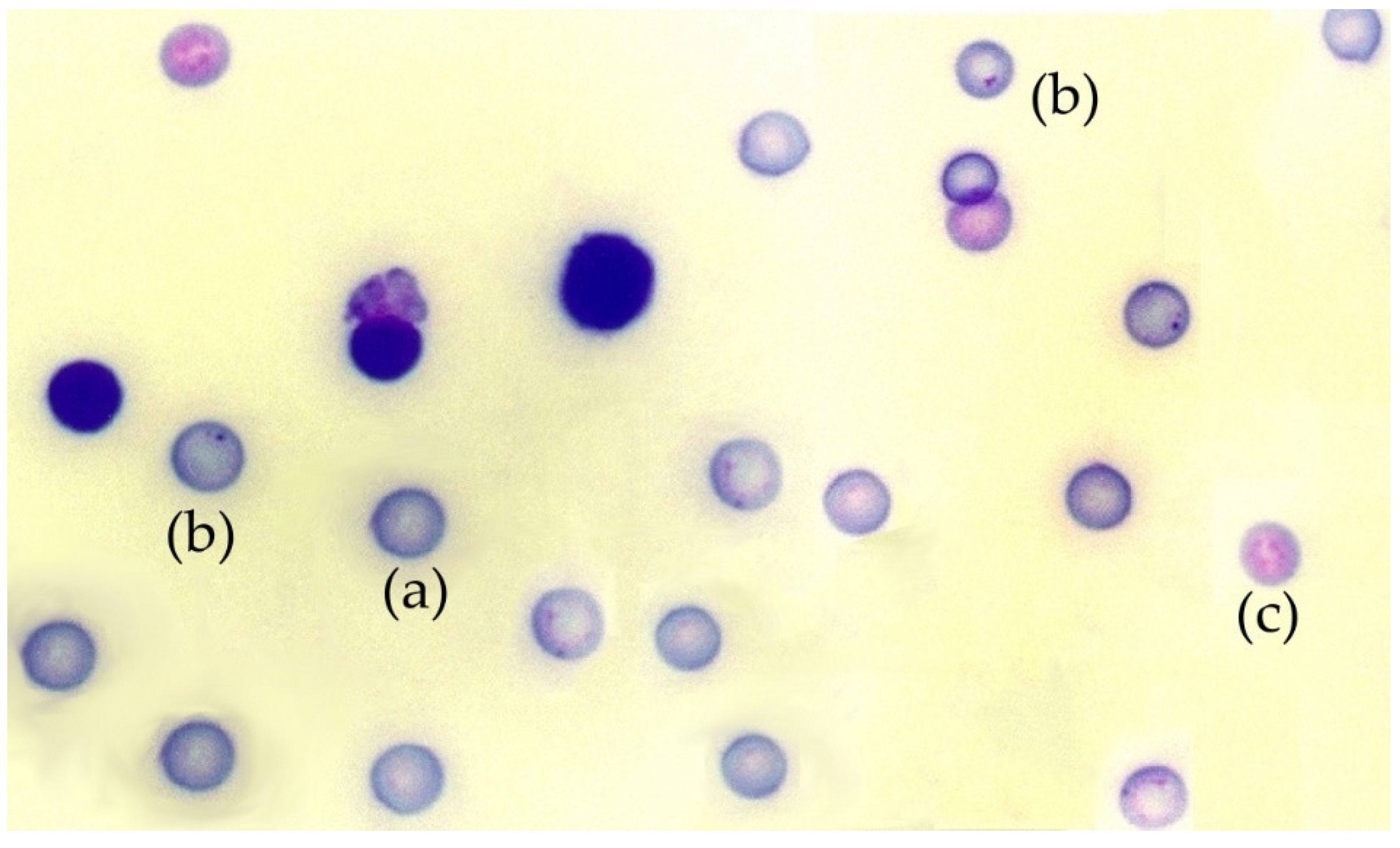
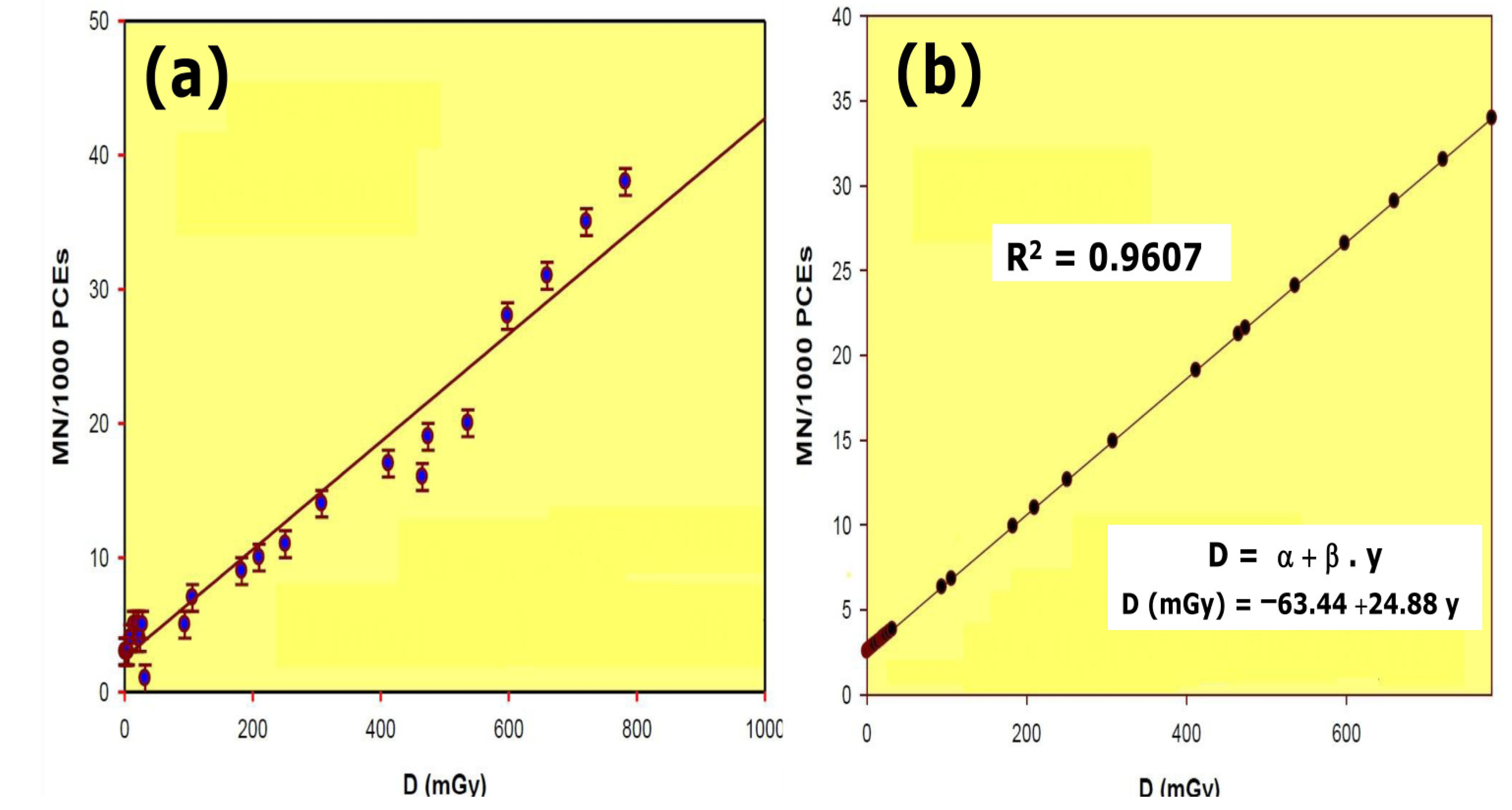

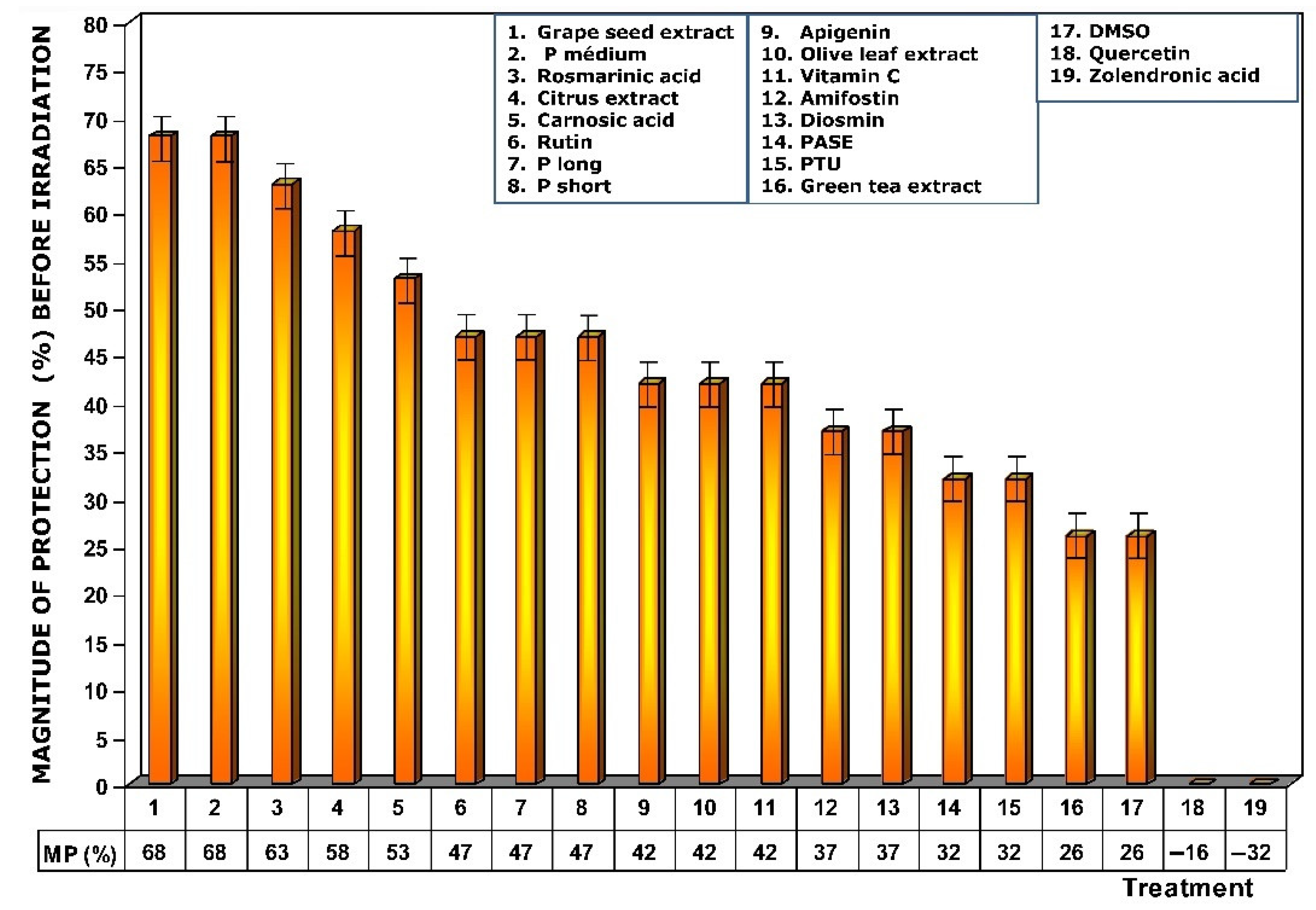
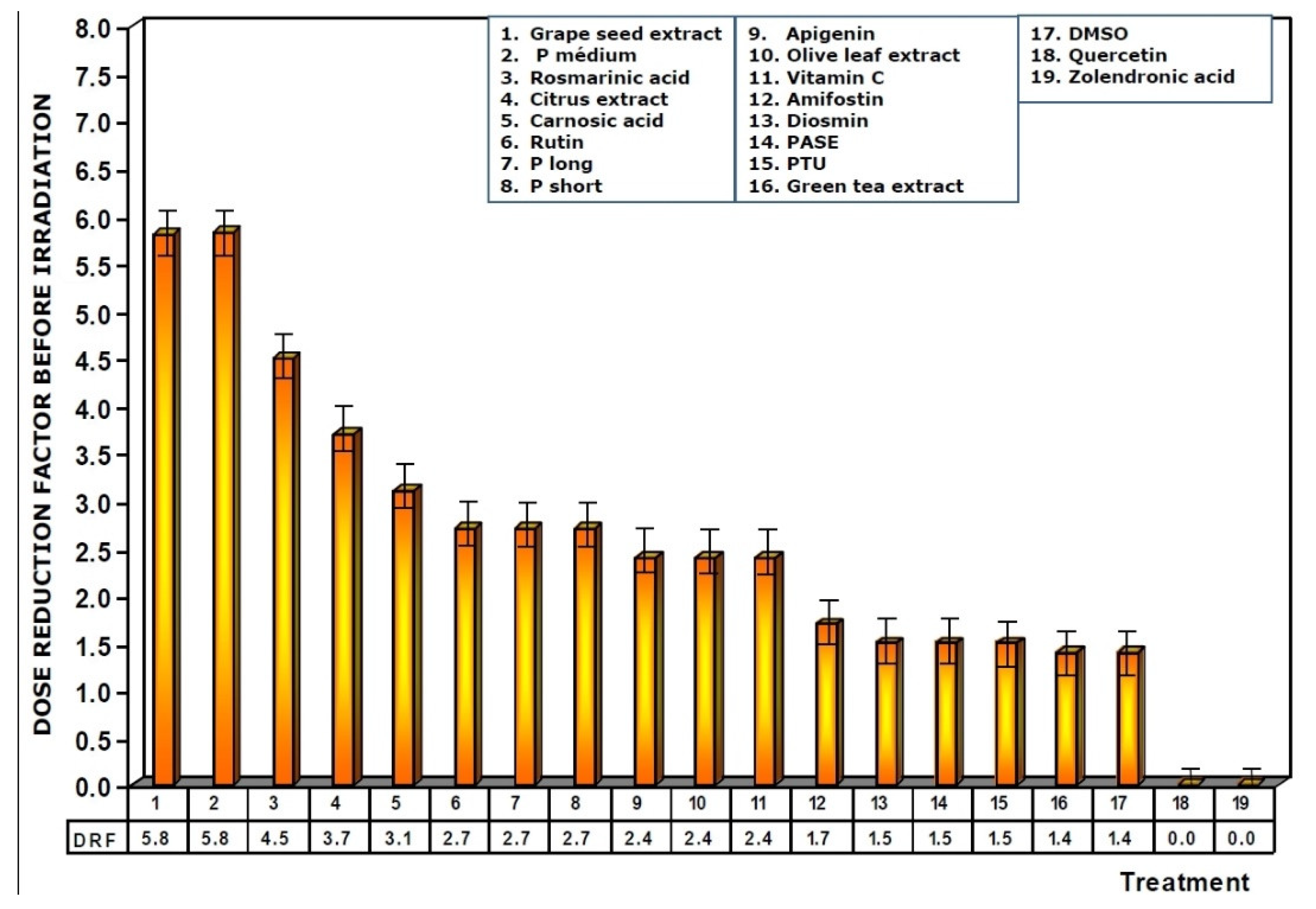
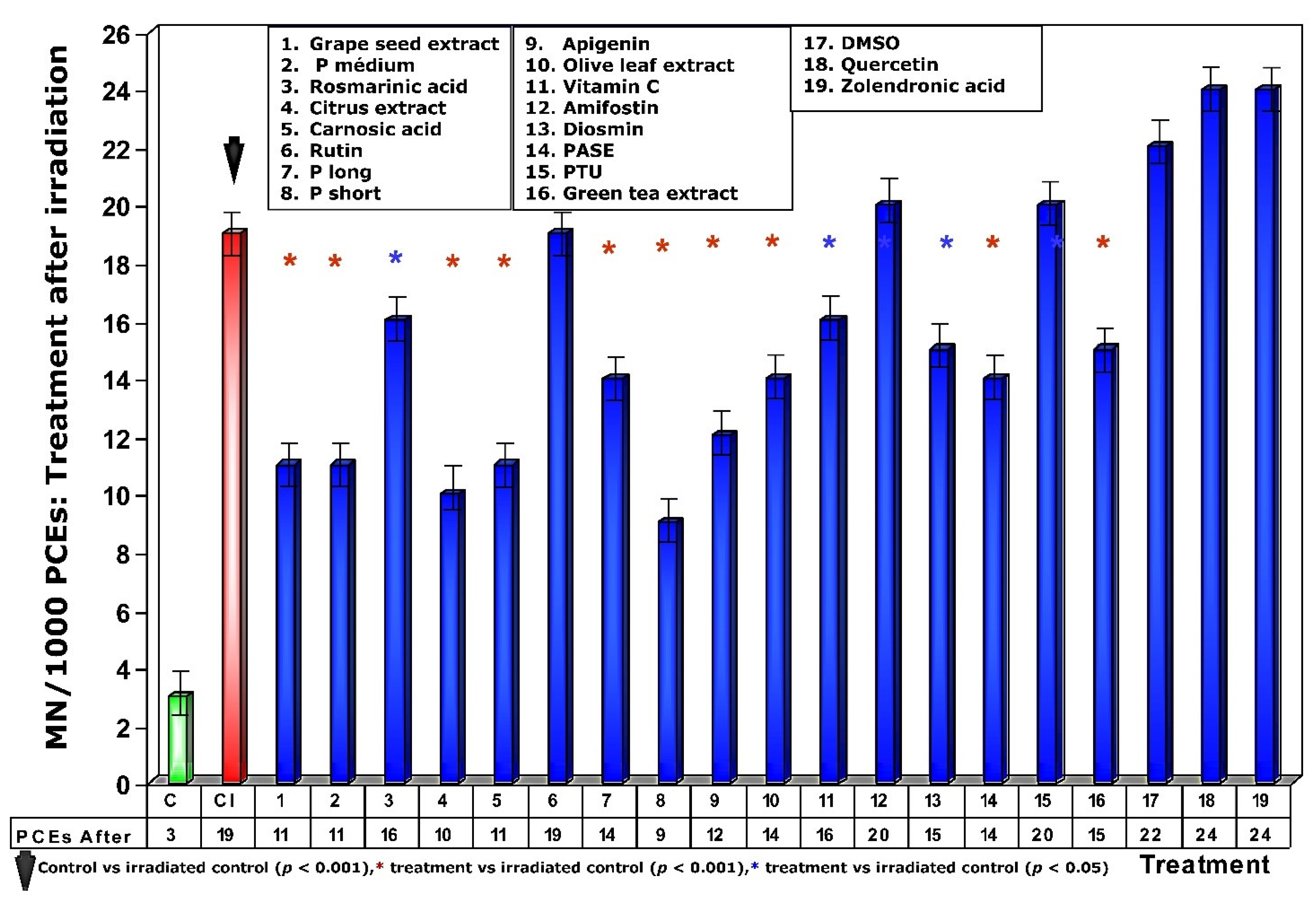
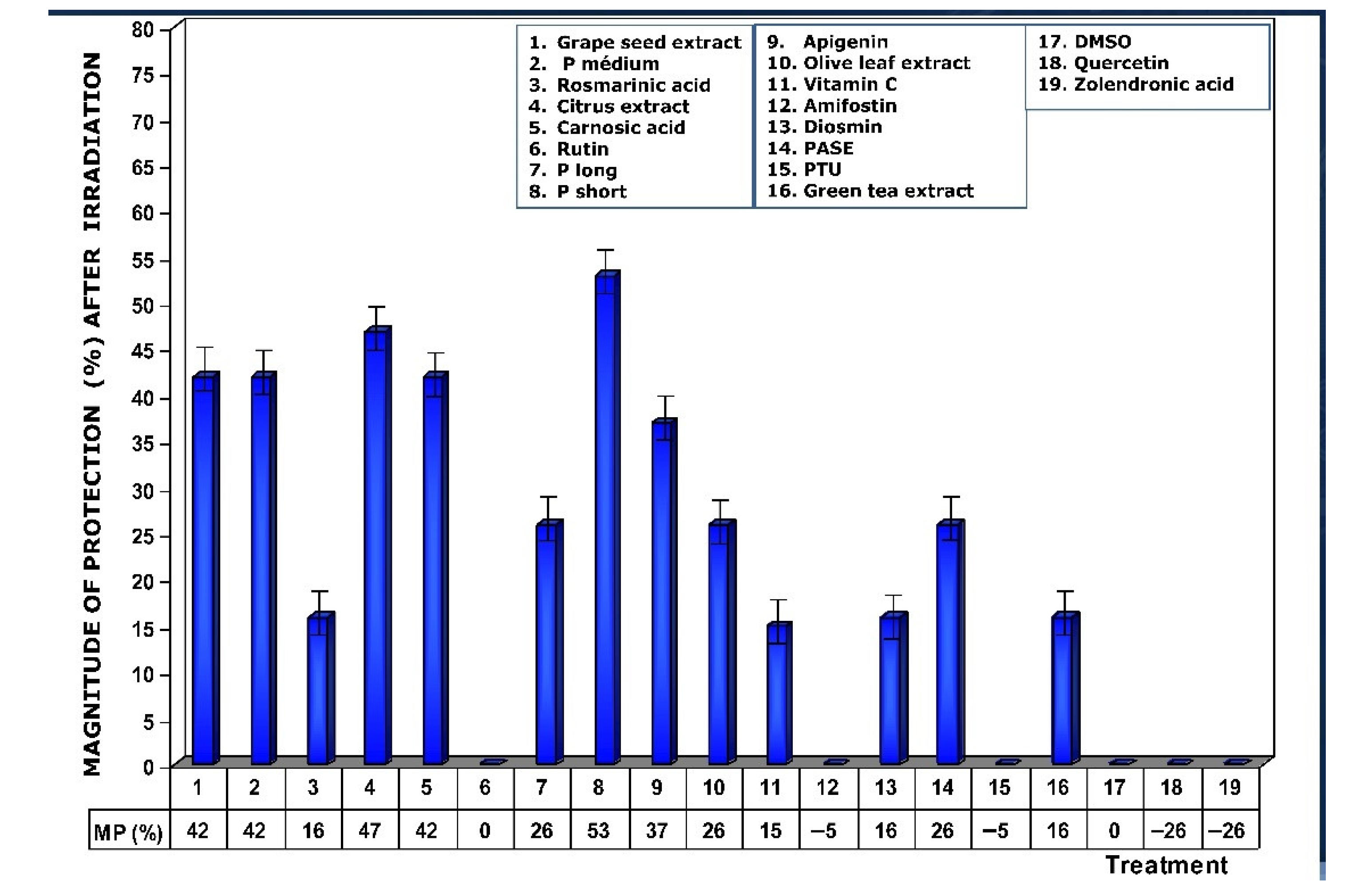
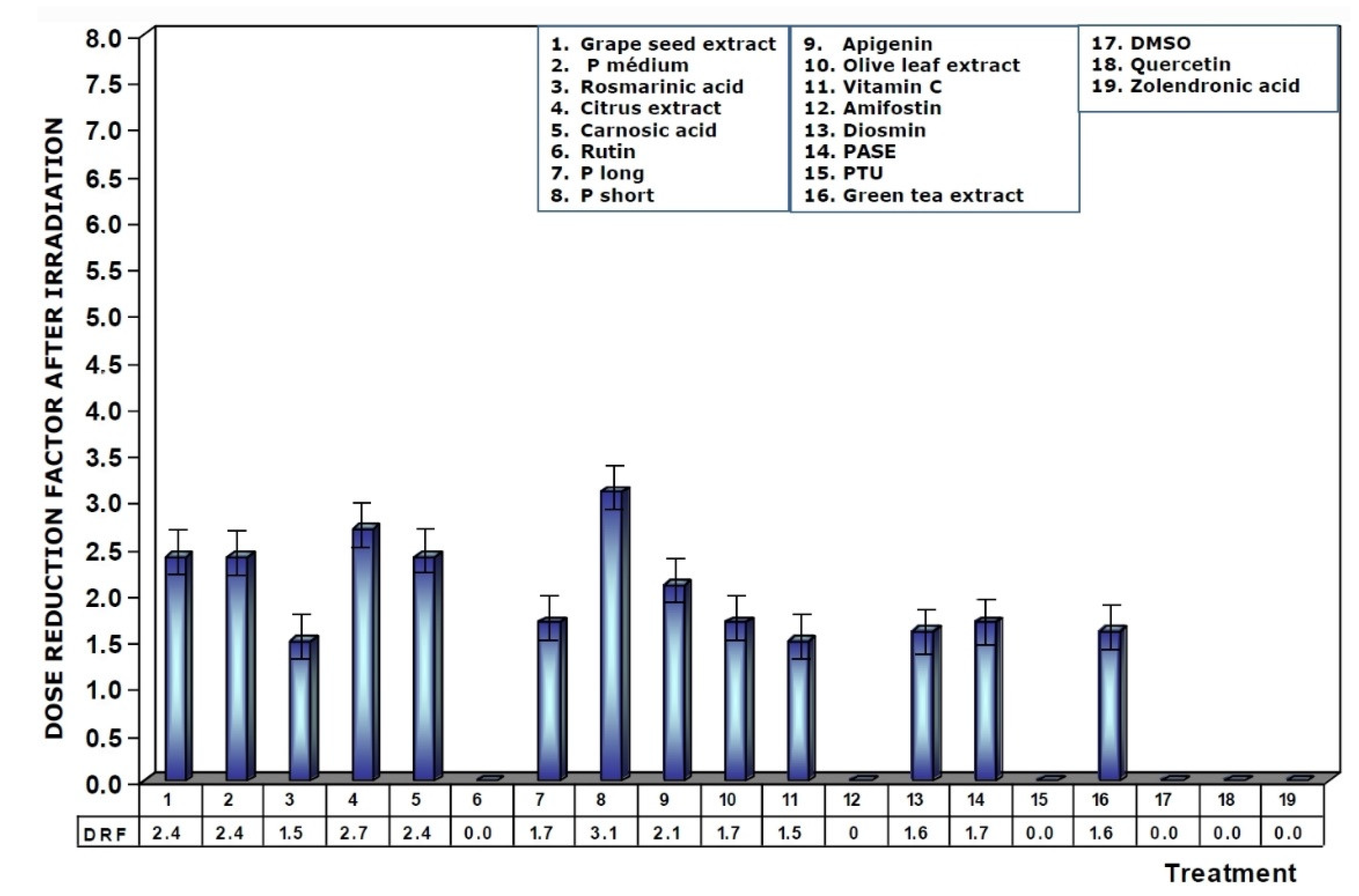

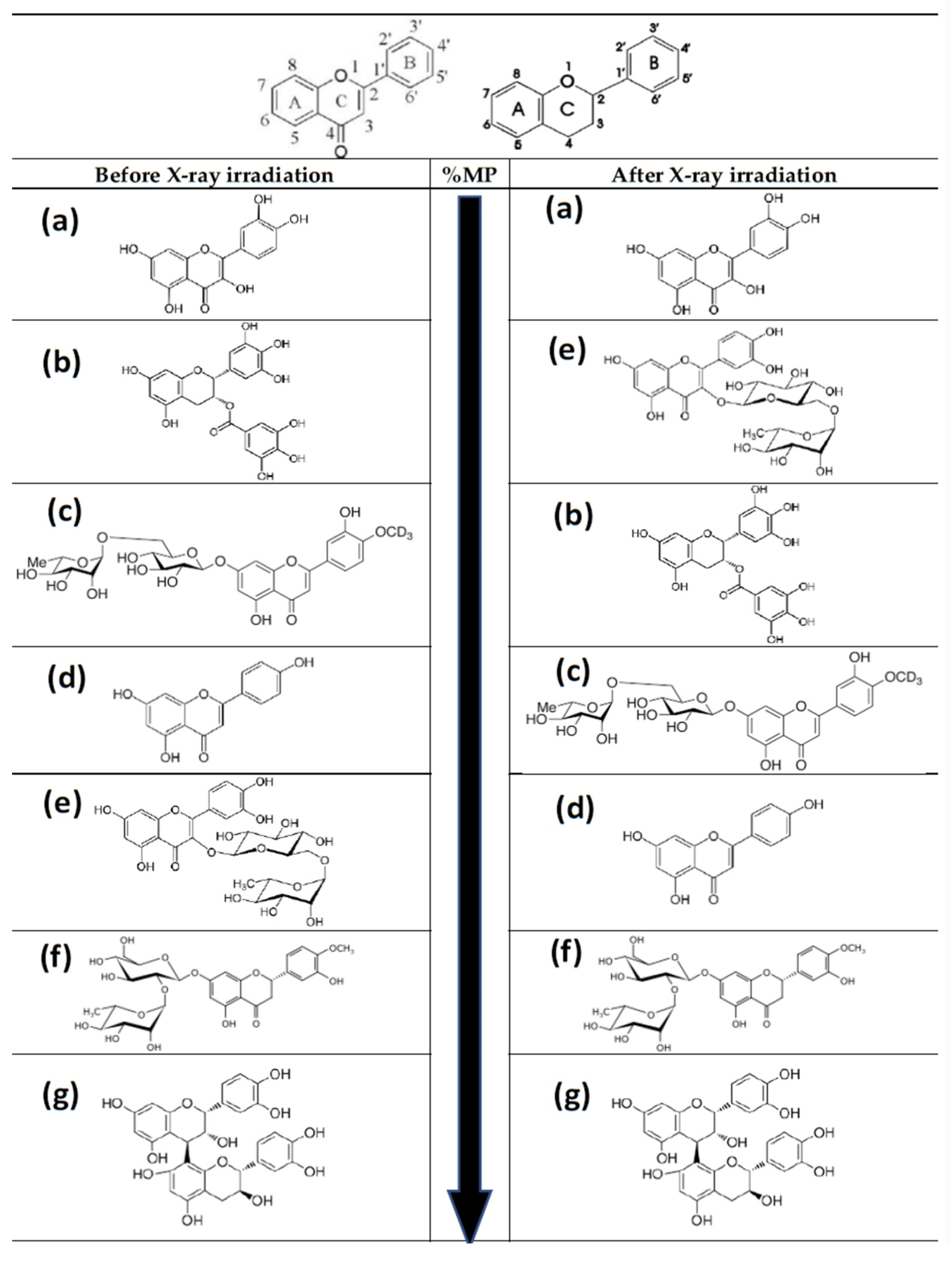
| No | COMPOUND | %MP BEFORE | %MP AFTER | DMSO | %MP BEFORE COMPENSATE | %MP AFTER COMPENSATE * | STRUCTURAL CONSIDERATIONS |
|---|---|---|---|---|---|---|---|
| 1 | Grape seed Ex. | 68 | 42 | N | 68 | 42 (−38%) | Flavonoid: flavan-3-ols (catechins); mixture of monomers, dimers and polymers C1-C15 catechin units. Presence of catechol and gallic groups. Water soluble |
| 2 | P medium | 68 | 42 | N | 68 | 42 (−38%) | Flavonoid: flavan-3-ols (catechins); mixture of monomers, dimers and polymers C1-C15 catechin units. Presence of catechol and gallic groups. Water soluble. 10% of monomers and dimers |
| 3 | Rosmarinic acid | 63 | 16 | N | 63 | 16 (−75%) | Di-Caffeoyl compound; free carboxilic group. Water soluble |
| 4 | Citrus Ex. | 58 | 47 | N | 58 | 47 (−19%) | Flavonoid: flavanone glycosides (naringin and neohesperidin). NO C2 = C3 double bond, NO catechol group. Water soluble. |
| 5 | Carnosic acid | 53 | 42 | Y | 27 | 42 (+56%) | Diterpene: free carboxilic group; catechol group. NO water soluble, lipid soluble. |
| 6 | Rutin | 47 | 0 | Y | 21 | 0 (−100%) | Flavonoid: flavonol glycoside; C2 = C3 double bond; catechol group. NO water soluble. |
| 7 | P long | 47 | 26 | N | 47 | 26 (−45%) | Flavonoid: flavan-3-ols (catechins); mixture of monomers, dimers and polymers C1-C15 catechin units. Presence of catechol and gallic groups. Sligthy watersoluble. 1% of monomers and dimers |
| 8 | P short | 47 | 53 | N | 47 | 53 (+13%) | Flavonoid: flavan-3-ols (catechins); mixture of monomers, dimers and polymers C1-C15 catechin units. Presence of catechol and gallic groups. Watwr soluble,25% of monomers and dimers |
| 9 | Apigenin | 42 | 37 | Y | 16 | 37 (+131%) | Flavonoid: flavone aglycon; C2 = C3 double bond; NO catechol group. NO water soluble. |
| 10 | Olive leaf Ex. | 42 | 26 | Y | 16 | 26 (+63%) | Secoiridoid + minor flavonoids: oleuropein; catechol group and sterified carbonyl groups. Partially water soluble. |
| 11 | Vitamin C | 42 | 15 | N | 42 | 15 (−64%) | (R)-3,4-dihydroxy-5-((S)-1,2-dihydroxyethyl) furan-2(5H)-one. Presence of orto-dihydroxy structure, Water soluble. |
| 12 | Amifostine | 37 | −5 | N | 37 | −5 (−114%) | S-phospho derivative of 2-[(3-aminopropyl) amino] ethanethiol. Organothiophosphate with a free amino group. Water soluble |
| 13 | Diosmin | 37 | 16 | Y | 11 | 16 (+45%) | Flavonoid: flavone glycoside; C2 = C3 double bond; NO catechol group. NO water soluble. |
| 14 | PASE | 32 | 26 | Y | 6 | 26 (+333%) | Sargahydroquinoic acid ((2Z,6E,10E)-12-(2,5-dihydroxy-3-methylphenyl)-6,10-dimethyl-2-(4-methylpent-3-enyl) dodeca-2,6,10-trienoic acid, Structure para-hydroxy phenolic and free carboxilic group. NO water soluble. |
| 15 | PTU | 32 | −5 | N | 32 | −5 (−116%) | Propylthiouracil. Water soluble (after dissolution in NaOH 0.15N adjusting to pH 8.5). |
| 16 | Green tea Ex. | 26 | 16 | Y | 0 | 16 (>+100%) | Flavonoid: flavan-3-ols (catechins: EGCG, EGC. ECG….all are monomers); presence of catechol and mainly gallic groups. Sligthy watersoluble |
| 17 | DMSO | 26 | 0 | Y | Dimethylsulfoxide. Water soluble | ||
| 18 | Quercetin | −16 | −26 | Y | −42 | −26 | Flavonoid: flavonol aglycon; C2 = C3 double bond; catechol group, five free hydroxyl groups (can be pro-oxidant). NO water soluble |
| 19 | Zoledronic acid | −32 | −26 | N | −58 | −26 | Imidazole (biphosphonate): 2,2-bis(phosphono)-2-hydroxyethane-1-yl. Sparingly soluble |
| Magnitude of Protection (Before X rays) | Magnitude of Protection (After X rays) |
|---|---|
| Flavonol aglycon (quercetin) | Flavonol aglycon (quercetin) |
| Flavan-3-ol galloylated (green tea extract) | Flavonol 3-O-glycoside (rutin) |
| Flavone 7-O-glycoside (diosmin) | Flavan-3-ol galloylated (green tea extract) |
| Flavone aglycon (apigenin) | Flavone 7-O-glycoside (diosmin) |
| Flavonol 3-O-glycoside (rutin) | Flavone aglycon (apigenin) |
| Flavanone 7-O-glycoside (citrus extract) | Flavanone 7-O-glycoside (citrus extract) |
| Flavan-3-ol (procyanidins) | Flavan-3-ol (procyanidins) |
Publisher’s Note: MDPI stays neutral with regard to jurisdictional claims in published maps and institutional affiliations. |
© 2021 by the authors. Licensee MDPI, Basel, Switzerland. This article is an open access article distributed under the terms and conditions of the Creative Commons Attribution (CC BY) license (https://creativecommons.org/licenses/by/4.0/).
Share and Cite
Alcaraz, M.; Olivares, A.; Achel, D.G.; García-Gamuz, J.A.; Castillo, J.; Alcaraz-Saura, M. Genoprotective Effect of Some Flavonoids against Genotoxic Damage Induced by X-rays In Vivo: Relationship between Structure and Activity. Antioxidants 2022, 11, 94. https://doi.org/10.3390/antiox11010094
Alcaraz M, Olivares A, Achel DG, García-Gamuz JA, Castillo J, Alcaraz-Saura M. Genoprotective Effect of Some Flavonoids against Genotoxic Damage Induced by X-rays In Vivo: Relationship between Structure and Activity. Antioxidants. 2022; 11(1):94. https://doi.org/10.3390/antiox11010094
Chicago/Turabian StyleAlcaraz, Miguel, Amparo Olivares, Daniel Gyingiri Achel, José Antonio García-Gamuz, Julián Castillo, and Miguel Alcaraz-Saura. 2022. "Genoprotective Effect of Some Flavonoids against Genotoxic Damage Induced by X-rays In Vivo: Relationship between Structure and Activity" Antioxidants 11, no. 1: 94. https://doi.org/10.3390/antiox11010094
APA StyleAlcaraz, M., Olivares, A., Achel, D. G., García-Gamuz, J. A., Castillo, J., & Alcaraz-Saura, M. (2022). Genoprotective Effect of Some Flavonoids against Genotoxic Damage Induced by X-rays In Vivo: Relationship between Structure and Activity. Antioxidants, 11(1), 94. https://doi.org/10.3390/antiox11010094









